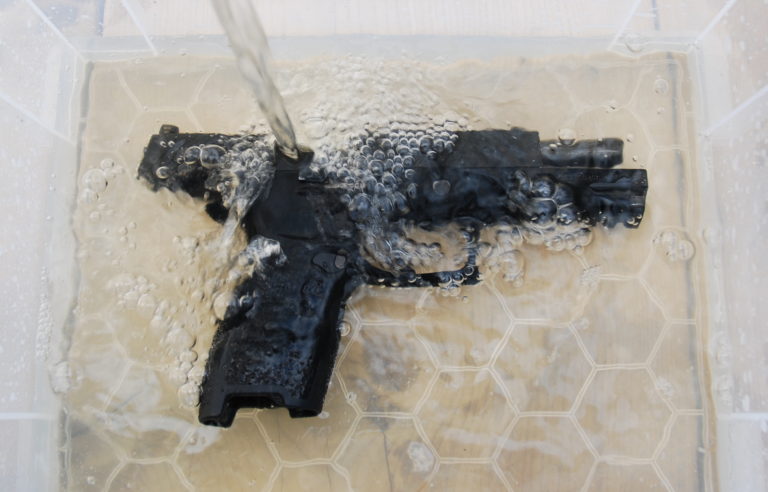
Not every range day or hunting trip is dry and sunny; sometimes guns get wet. Some competitions and training events can even be wet on purpose, and hunting season on the British Columbian coast is not exactly arid!
Using your firearm whilst it’s wet from rain or puddle splashes is usually not unsafe, as long as the barrel isn’t plugged with water. But it’s generally a bad idea to shoot your gun while fully, or even partially, submerged. Whilst some firearms are built to withstand such rigours, firing a gun underwater is potentially dangerous and could lead to severely damage of both the firearm and the shooter.
Your handgun, rifle, or shotgun is not likely to suffer from being wet in the short-term; the main issues occur if firearms are neglected and remain wet for long periods of time. Moisture, even in tiny amounts, can lead to rust. And rust very quickly leads to a ruined firearm.
Even stainless steel firearms can - and will - rust if stored wet. Not only will the metal components suffer, but wood stocks will split and rot. And even the toughest laminate furniture can swell, delaminate, and go moldy.
So it is extremely important to make sure your firearm is completely dry, and properly cleaned and lubed before being locked away. I cannot stress this enough: NEVER STORE A WET FIREARM.
Before you start the drying process, you should prepare the area: clear a suitable space, gather your cleaning supplies, and remove all live ammunition from the vicinity. Then take your firearm, PROVE it safe, and then disassemble (field strip) the firearm according to the manufacturer’s normal recommended cleaning procedure.
If the gun was exposed to dirty/salt water, rinse all the parts in fresh, clean water first. But you can skip this step if it only got wet from rain.
Next, blow out all the parts with compressed air, but take care not to blow springs and other small parts loose. Canned air dusters are ideal but can be expensive, so most people use a standard workshop air compressor. Bear in mind that most compressors tend to build up condensation in the tank, so the air they blow out may not be completely dry but, nevertheless, it will still help to remove the bulk of water from the workings of the gun.
Now you should manually dry any exposed areas with shop cloths, and use Q-tips to swab moisture out of tight spaces. Be careful if you’re using paper towels; these can easily tear and leave fragments and lint behind.
At this stage, the gun may look and feel dry, but there could still be dampness lurking within. The best way to ensure that your firearm gets 100% dry is to air it out.
If you have a safe and legal enclosed area where you can leave the gun unattended for a while, then I recommend placing all the parts on a wire rack, and running a dehumidifier or a fan for a few hours. Alternatively, you could seal the parts with some damp-rid, silica gel, or other desiccant, inside an airtight container such as Pelican or Nanuk-type cases with the foam removed (or even ziplock bags for small handguns), and leave them overnight.
Once the firearm is completely free of moisture, you need to thoroughly clean and lubricate it as per the manufacturer’s procedure then, finally, it’ll be ready to lock away.
It’s also a good idea to keep some damp-rid, or other dehumidifying device, inside your gun safe too - this will help to keep rust and mold at bay while your firearms have a well earned rest.
Want some more info on cleaning and maintaining your firearm? Have a look at our list of Do’s and Don’t’s of Firearm Cleaning.